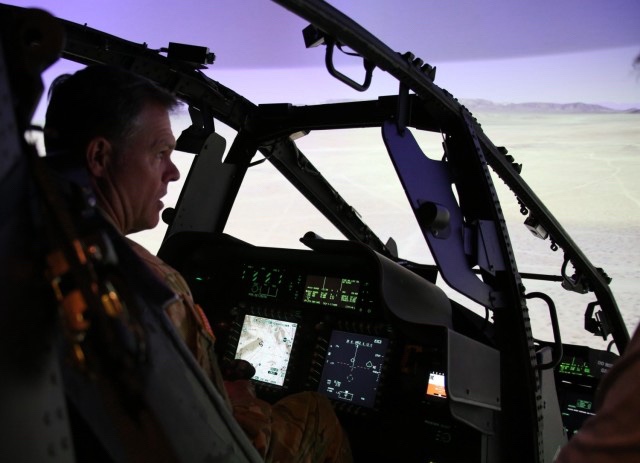
REDSTONE ARSENAL, Ala. — If a technology isn’t intuitive, chances are, it won’t be used.
True in everyday life and especially true in aviation when creating technology to support Army aviators. Partnering with Program Executive Office – Aviation’s project offices, the U.S. Army Combat Capabilities Development Command Aviation & Missile Center conducts government-executed Crew Station Working Groups to assess the avionics requirements through human-factors engineering, utilizing early Soldier evaluations.
The key mission of the DEVCOM AvMC Aviation Crew Stations Branch is conducting CSWGs comprising Army and industry partner stakeholders, all with a vested interest in ensuring that Army aviators have the best solution at their fingertips.
“We support the end user,” said Jena Salvetti, lead human factors engineer for the Crew Stations branch. “We evaluate prototype interfaces, with users-in-the-loop, while addressing human factors principles, aviation mission tasks, and sub-system conventions to ensure that final designs are intuitive. The CSWG process was designed to ensure aviators have a say in their interfaces rather than pushing an interface to the field and saying, ‘You’ll figure it out.’ One of the things we hear from the field is that systems are not being used because they’re too hard to use. The CSWG was created to mitigate this issue.”
For more than 25 years, AvMC has partnered with the Utility and Cargo Helicopter Project Offices leading the working group activities. With the demonstrated success of more than 115 CSWG activities across 13 project offices and seven airframes, the Apache Helicopter Project Office joined the partnership with the fielding of the AH-64E.
One of the ways that the Aviation Crew Stations Branch ensures that they are designing with the user — or pilot — in mind is utilizing former Army pilots to lead the process. They have seven.
“This is a really unique branch in the number of users we have in the group,” said Kevin Bieri, aerospace engineer. The Aviation Crew Stations Branch, totaling 10 civilians with contracting support, is divided into three teams: platform leads, human factors and engineering.
“There’s a lot of experience in the room,” Ross Lewallen, AH-64E Crew Station Working Group lead, said.
Of course, anyone familiar with Army aviation knows that pilots won’t hold back when it comes to talking shop — or how to make the aircraft better.
“You have two pilots in a room and get three opinions,” Bieri said with a laugh.
The team agreed the reason why the CSWG works so well is due to the rapid prototyping that takes place during those Soldier evaluations. When the pilots give their evaluation, often the engineers will immediately make the adjustments to the technology. In the world of engineering, to have that instant impact is immensely rewarding, they said.
The challenge is that sometimes they work too fast, Lewallen said, evaluating technology for the CSWG that is not yet mature. It’s a unique challenge but one that they accept, to continue to bring the best capabilities to the Soldiers.
“We are three to five years ahead of the product line,” said Lewallen. “Which is good because some of the things that we’re working on, we’re given a blank slate. They ask, ‘How do you think this will work?’ And that’s when we use the experience we have in the lab — former pilots, engineers, aerospace guys, all of our talents — to come up with something. Then we fly and make some modifications to it to fit with the users want. We know a long time ahead of the airframe what it’s going to look like. I think that is that is a unique part of our job. I love it. It’s one of my favorite parts — getting out ahead of the conception line.”
By Katie Davis Skelley, DEVCOM Aviation & Missile Center Public Affairs

